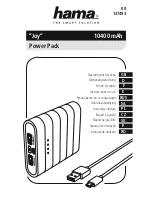
+44 (0)1543 443060
www.secontrols.com
Please keep these operating instructions for future reference and maintenance.
Subject to technical modifications. Diagram is not binding.
24
5.4.
Battery installation
Once all other connection to the panel has
been made and the installation is ready
for commissioning, fit the batteries.
The PSU panel will not power up from just
batteries until the main power is first applied
or the ‘battery power up’ button is pressed.
Connect the red lead to the red terminal of one
battery and the black lead to the black terminal
of the other battery. Complete the circuit by
connecting the black link wire between the
batteries using the unused battery terminals.
Take care to never short circuit batteries
as a hazardous high current will result.
If the system is not to be commissioned/
used for some time, ensure the system is left
in the disconnected power-down state.
5.5.
First power-up tests.
Before powering up a system for the
first time, ensure the actuator and vent
installation is complete and operation of
the actuators will not cause a hazard.
Full commissioning of a new system requires
the availability of mains electrical supply.
If activation is via a fire alarm controlled relay,
ensure the fire alarm system is reset.
With mains power removed, use a multimeter
to measure the open circuit voltage on each
battery. Check that the voltage is more than
10.5V for a new discharged battery, and more
than 12.6V for batteries that are fully charged.
Where batteries have been left connected and
deep discharged, there is the risk of internal
damage to the batteries and should be replaced.
Reconnect the batteries and connect the
mains supply. The battery charging should
start within 30 seconds and may be checked
by measuring an increase in battery voltage.
For networked systems, an unbound, faulty
or disconnected OSlink card may cause a
fault indication. For OSLink, Check the green
status led of the network, and if necessary
re-initialise the network by pressing the
‘learn’ button on the OSLink card.
Test the operation of the actuator by activation
of the system. Ensure the actuator operates
smoothly and adjust if necessary.
Where a ‘Cause and Effect’ functional specification
is available, this will document a complete list of
the required functions which must all be verified in
turn. If this specification detail is not available, the
commissioning engineer must ensure that each
input is tested. This may require triggering of smoke
detectors and simulating of fire alarm inputs.
If the system is not to be used for some time,
ensure the system is left in the disconnected
power-down state. If necessary, press
the disconnect button on the PSU.








































